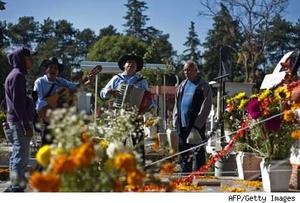On these first two days of November, sometimes called the Day of All Saints and the Day of the Loyal Dead, many Mexicans bring offerings (ofrendas) to “our dead”—relatives, friends, and sympathetic public figures who have died within living memory. This year, small groups around the country are using the occasion to remember the thousands of people who died violently over the past year at the hand of one or another collection of combatants in the country’s many-sided war against (and amongst) organized crime.
 Here in Cuernavaca, a group will commemorate those violent deaths by marching late this afternoon (Tuesday, November 1) from a monument in the north of the city called the Paloma of Peace, to the city’s central square, the Zócalo, where multiple ofrendas have already been placed. The march has been called by a group formed a few months ago called the Network for Peace with Justice and Dignity.
Here in Cuernavaca, a group will commemorate those violent deaths by marching late this afternoon (Tuesday, November 1) from a monument in the north of the city called the Paloma of Peace, to the city’s central square, the Zócalo, where multiple ofrendas have already been placed. The march has been called by a group formed a few months ago called the Network for Peace with Justice and Dignity.
Last May, well over 100,000 marchers filled Mexico City’s Zócalo, demanding an end to the country’s routine daily violence. Unlike many previous demonstrations for public safety, notably a massive March Against Insecurity in 2004, this National March for Peace with Justice and Dignity called for less military presence rather than more.
Today’s smaller events, loosely and locally organized within the same civic network—much like the decentralized Occupy demonstrations north of the border—have touched the same responsive chord as did the massive march last Spring. They seek to reframe the debates around crime and trafficking from “How do we defeat the narcos?” to “How do we reconstitute our country so that it no longer provides fertile soil for the activities of organized crime?” The growth of the network suggests that the reframing is well underway. The broad demands for Peace with Justice and Dignity still resonate. They are the same as they were last May:
1. Transparency: the active investigation of all murders, disappearances, kidnappings, clandestine graves, and person trafficking, along with the publication of the names of the victims and the “material and intellectual authors” of these crimes.
2. Demilitarization: the end of the military strategy of the fight against organized crime and its transformation into a program of citizen security and human rights.
3. An end to corruption and impunity: the elimination of immunity to prosecution of public officials suspected of having links to organized crime, public corruption, or crimes against the common good.
4. Strategic intervention in markets: an attempt to end the economic roots and profitability of organized crime, particularly by combating money laundering and, more controversially, by decriminalizing selective drugs like marijuana.
5. The generation of decent employment and education: the creation of real opportunities for young people, along with the recovery of a social compact among citizens.
6. The creation of a democracy that is both participatory and more effectively representative: the democratization of the communications media to allow for more effective citizen participation.
The invitation to today’s march in Cuernavaca reads as follows: Carrying candles and crosses we will march from the Paloma of Peace to the offering in the Government Palace. We will dress in white, and march in silence, with the utmost respect for the more than 50,000 dead. Without anybody leading, without official chants, with the sole intention of reflecting while we walk, without distinctions of religion or ideology, we will carry hearts representing each of the fallen in this war.
For more on the Mexican drug war, read the May/June 2011 NACLA Report "Mexico's Drug Crisis." For more from Fred Rosen's blog, "Mexico, Bewildered and Contested," visit nacla.org/blog/mexico-bewildered-contested. You can also read NACLA blogs, Border Wars or Traffick Jam, for more on the U.S.-Mexico border or drug trafficking in the region.
Did you find this useful? Donate to NACLA

